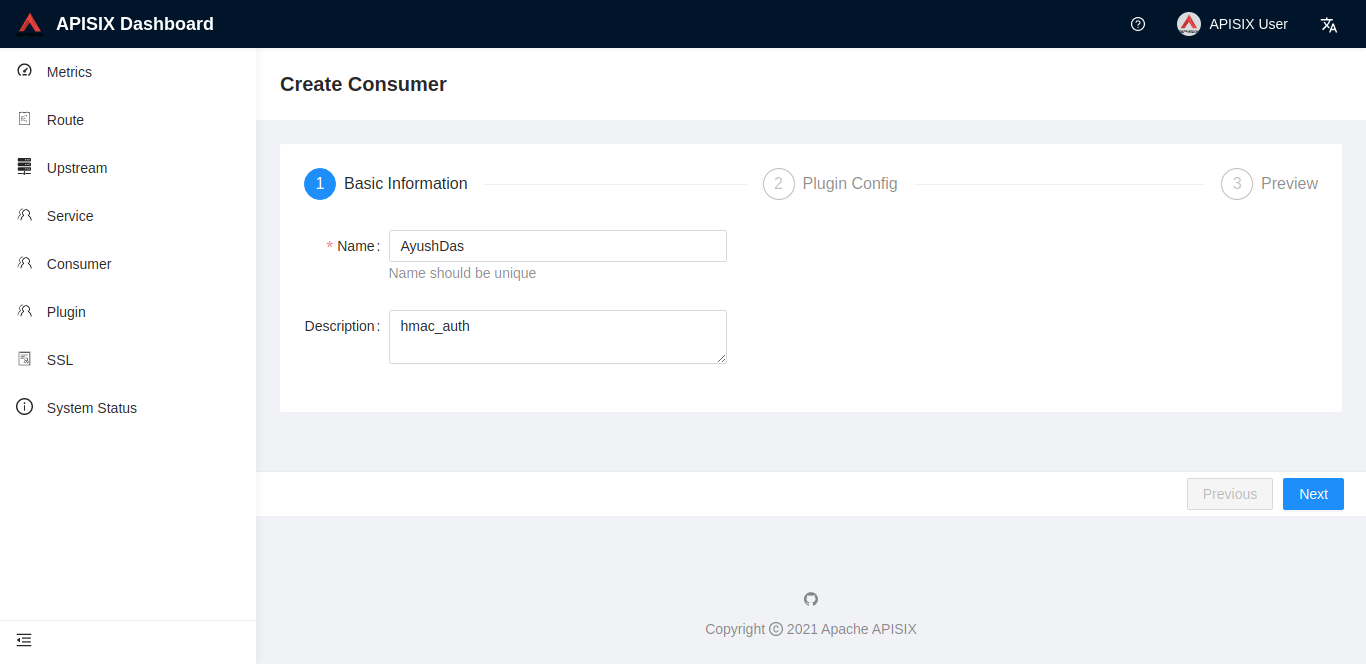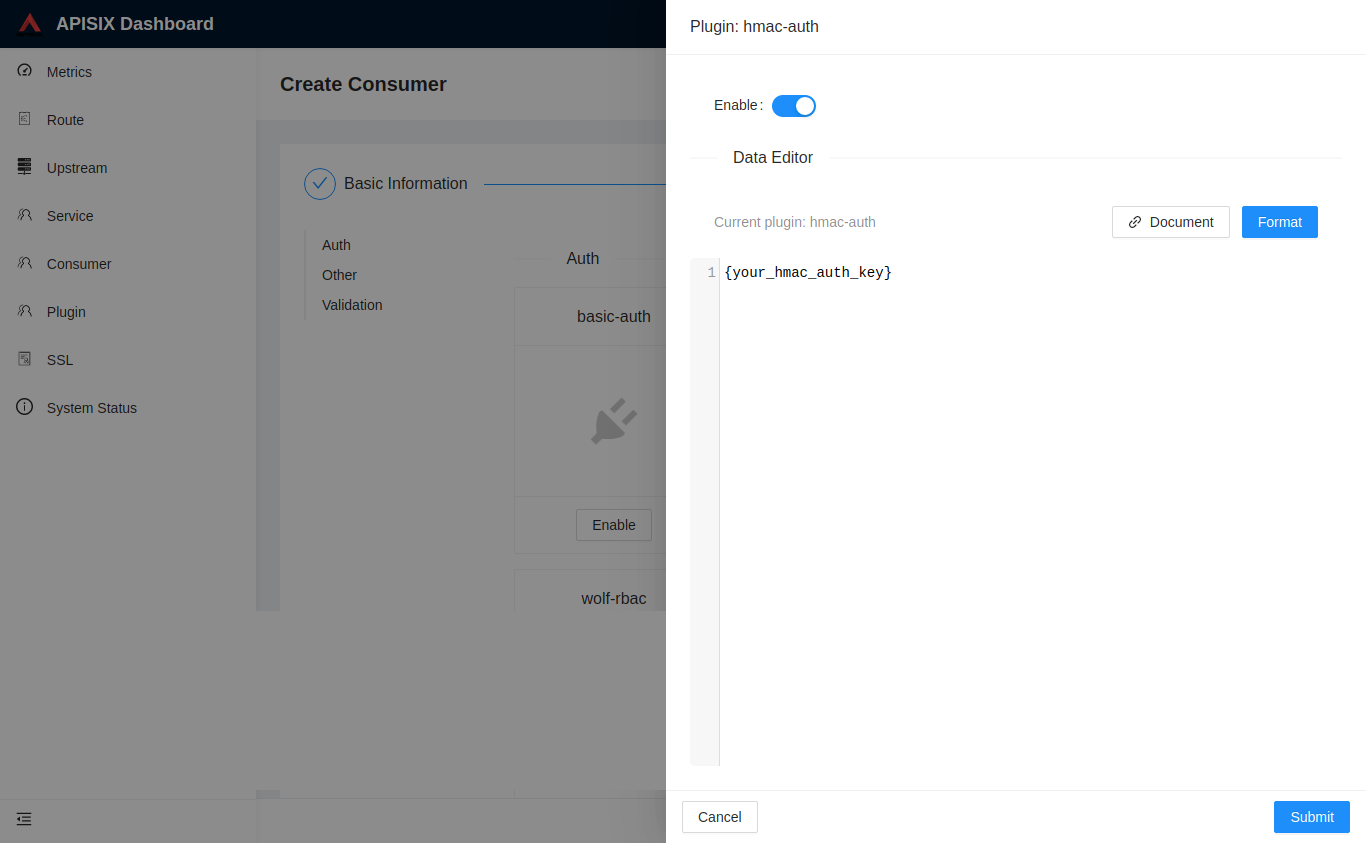hmac-auth
Summary#
- Summary
- Name
- Attributes
- How To Enable
- Test Plugin
- Custom header key
- Disable Plugin
- Generate Signature Examples
Name#
hmac-auth is an authentication plugin that need to work with consumer. Add HMAC Authentication to a service or route.
The consumer then adds its key to request header to verify its request.
Attributes#
| Name | Type | Requirement | Default | Valid | Description |
|---|---|---|---|---|---|
| access_key | string | required | Different consumer objects should have different values, and it should be unique. If different consumers use the same access_key, a request matching exception will occur. | ||
| secret_key | string | required | Use as a pair with access_key. | ||
| algorithm | string | optional | "hmac-sha256" | ["hmac-sha1", "hmac-sha256", "hmac-sha512"] | Encryption algorithm. |
| clock_skew | integer | optional | 0 | The clock skew allowed by the signature in seconds. For example, if the time is allowed to skew by 10 seconds, then it should be set to 10. especially, 0 means not checking Date | |
| signed_headers | array[string] | optional | Restrict the headers that are added to the encrypted calculation. After the specified, the client request can only specify the headers within this range. When this item is empty, all the headers specified by the client request will be added to the encrypted calculation | ||
| keep_headers | boolean | optional | false | [ true, false ] | Whether it is necessary to keep the request headers of X-HMAC-SIGNATURE, X-HMAC-ALGORITHM and X-HMAC-SIGNED-HEADERS in the http request after successful authentication. true: means to keep the http request header, false: means to remove the http request header. |
| encode_uri_params | boolean | optional | true | [ true, false ] | Whether to encode the uri parameter in the signature, for example: params1=hello%2Cworld is encoded, params2=hello,world is not encoded. true: means to encode the uri parameter in the signature, false: not to encode the uri parameter in the signature. |
How To Enable#
- set a consumer and config the value of the
hmac-authoption
curl http://127.0.0.1:9080/apisix/admin/consumers -H 'X-API-KEY: edd1c9f034335f136f87ad84b625c8f1' -X PUT -d '{ "username": "jack", "plugins": { "hmac-auth": { "access_key": "user-key", "secret_key": "my-secret-key", "clock_skew": 0, "signed_headers": ["User-Agent", "Accept-Language", "x-custom-a"] } }}'The default keep_headers is false and encode_uri_params is true.
You can visit the dashboard to complete the above operations through the web interface, first add a consumer:

Then add the hmac-auth plugin to the consumer page:

- add a Route or add a Service, and enable the
hmac-authplugin
curl http://127.0.0.1:9080/apisix/admin/routes/1 -H 'X-API-KEY: edd1c9f034335f136f87ad84b625c8f1' -X PUT -d '{ "uri": "/index.html", "plugins": { "hmac-auth": {} }, "upstream": { "type": "roundrobin", "nodes": { "39.97.63.215:80": 1 } }}'Test Plugin#
generate signature:#
The calculation formula of the signature is signature = HMAC-SHAx-HEX(secret_key, signing_string). From the formula, it can be seen that in order to obtain the signature, two parameters, SECRET_KEY and signing_STRING, are required. Where secret_key is configured by the corresponding consumer, the calculation formula of signing_string is signing_string = HTTP Method + \n + HTTP URI + \n + canonical_query_string + \n + access_key + \n + Date + \n + signed_headers_string. If one of the items in signing_string does not exist, you also need to use an empty string instead.
- HTTP Method : Refers to the GET, PUT, POST and other request methods defined in the HTTP protocol, and must be in all uppercase.
- HTTP URI :
HTTP URIrequirements must start with "/", those that do not start with "/" need to be added, and the empty path is "/". - Date : Date in http header(GMT format).
- canonical_query_string :
canonical_query_stringis the result of encoding thequeryin the URL (queryis the string "key1 = valve1 & key2 = valve2" after the "?" in the URL). - signed_headers_string :
signed_headers_stringis the result of obtaining the fields specified by the client from the request header and concatenating the strings in order.
The coding steps of canonical_query_string are as follows:
- Extract the
queryitem in the URL, that is, the string "key1 = valve1 & key2 = valve2" after the "?" in the URL. - Split the
queryinto several items according to the & separator, each item is in the form of key=value or only key. - According to whether the uri parameter is encoded, there are two situations:
- When
encode_uri_paramsis true:- Encoding each item after disassembly is divided into the following two situations.
- When the item has only key, the conversion formula is uri_encode(key) + "=".
- When the item is in the form of key=value, the conversion formula is in the form of uri_encode(key) + "=" + uri_encode(value). Here value can be an empty string.
- After converting each item, sort by key in lexicographic order (ASCII code from small to large), and connect them with the & symbol to generate the corresponding canonical_query_string.
- When
encode_uri_paramsis false:- Encoding each item after disassembly is divided into the following two situations.
- When the item has only key, the conversion formula is key + "=".
- When the item is in the form of key=value, the conversion formula is in the form of key + "=" + value. Here value can be an empty string.
- After converting each item, sort by key in lexicographic order (ASCII code from small to large), and connect them with the & symbol to generate the corresponding canonical_query_string.
The signed_headers_string generation steps are as follows:
- Obtain the headers specified to be added to the calculation from the request header. For details, please refer to the placement of
SIGNED_HEADERSin the next sectionUse the generated signature to make a request attempt. - Take out the headers specified by
SIGNED_HEADERSin order from the request header, and splice them together in order ofname:value. After splicing, asigned_headers_stringis generated.
HeaderKey1 + ":" + HeaderValue1 + "\n"\+HeaderKey2 + ":" + HeaderValue2 + "\n"\+...HeaderKeyN + ":" + HeaderValueN + "\n"Signature string splicing example
Take the following request as an example:
$ curl -i http://127.0.0.1:9080/index.html?name=james&age=36 \-H "X-HMAC-SIGNED-HEADERS: User-Agent;x-custom-a" \-H "x-custom-a: test" \-H "User-Agent: curl/7.29.0"The signing_string generated according to the signature generation formula is:
"GET/index.htmlage=36&name=jamesuser-keyTue, 19 Jan 2021 11:33:20 GMTUser-Agent:curl/7.29.0x-custom-a:test"Note: The last request header also needs + \n.
Generate Signature
Use Python to generate the signature SIGNATURE:
import base64import hashlibimport hmac
secret = bytes('my-secret-key', 'utf-8')message = bytes("""GET/index.htmlage=36&name=jamesuser-keyTue, 19 Jan 2021 11:33:20 GMTUser-Agent:curl/7.29.0x-custom-a:test""", 'utf-8')
hash = hmac.new(secret, message, hashlib.sha256)
# to lowercase base64print(base64.b64encode(hash.digest()))| Type | Hash |
|---|---|
| SIGNATURE | 8XV1GB7Tq23OJcoz6wjqTs4ZLxr9DiLoY4PxzScWGYg= |
Use the generated signature to try the request#
$ curl -i "http://127.0.0.1:9080/index.html?name=james&age=36" \-H "X-HMAC-SIGNATURE: 8XV1GB7Tq23OJcoz6wjqTs4ZLxr9DiLoY4PxzScWGYg=" \-H "X-HMAC-ALGORITHM: hmac-sha256" \-H "X-HMAC-ACCESS-KEY: user-key" \-H "Date: Tue, 19 Jan 2021 11:33:20 GMT" \-H "X-HMAC-SIGNED-HEADERS: User-Agent;x-custom-a" \-H "x-custom-a: test" \-H "User-Agent: curl/7.29.0"
HTTP/1.1 200 OKContent-Type: text/html; charset=utf-8Transfer-Encoding: chunkedConnection: keep-aliveDate: Tue, 19 Jan 2021 11:33:20 GMTServer: APISIX/2.2......Below are two assembly forms of signature information
- The signature information is put together in the request header
Authorizationfield:
$ curl http://127.0.0.1:9080/index.html -H 'Authorization: hmac-auth-v1# + ACCESS_KEY + # + base64_encode(SIGNATURE) + # + ALGORITHM + # + DATE + # + SIGNED_HEADERS' -iHTTP/1.1 200 OKContent-Type: text/htmlContent-Length: 13175...Accept-Ranges: bytes
<!DOCTYPE html><html lang="cn">...- The signature information is separately placed in the request header:
$ curl http://127.0.0.1:9080/index.html -H 'X-HMAC-SIGNATURE: base64_encode(SIGNATURE)' -H 'X-HMAC-ALGORITHM: ALGORITHM' -H 'Date: DATE' -H 'X-HMAC-ACCESS-KEY: ACCESS_KEY' -H 'X-HMAC-SIGNED-HEADERS: SIGNED_HEADERS' -iHTTP/1.1 200 OKContent-Type: text/htmlContent-Length: 13175...Accept-Ranges: bytes
<!DOCTYPE html><html lang="cn">Note:
- ACCESS_KEY, SIGNATURE, ALGORITHM, DATE, SIGNED_HEADERS respectively represent the corresponding variables
- SIGNED_HEADERS is the headers specified by the client to join the encryption calculation. If there are multiple headers, they must be separated by ";":
x-custom-header-a;x-custom-header-b - SIGNATURE needs to use base64 for encryption:
base64_encode(SIGNATURE)
Custom header key#
We can customize header key for auth parameters by adding the attribute configuration of the plugin under plugin_attr in conf / config.yaml.
plugin_attr: hmac-auth: signature_key: X-APISIX-HMAC-SIGNATURE algorithm_key: X-APISIX-HMAC-ALGORITHM date_key: X-APISIX-DATE access_key: X-APISIX-HMAC-ACCESS-KEY signed_headers_key: X-APISIX-HMAC-SIGNED-HEADERSAfter customizing the header, request example:
$ curl http://127.0.0.1:9080/index.html -H 'X-APISIX-HMAC-SIGNATURE: base64_encode(SIGNATURE)' -H 'X-APISIX-HMAC-ALGORITHM: ALGORITHM' -H 'X-APISIX-DATE: DATE' -H 'X-APISIX-HMAC-ACCESS-KEY: ACCESS_KEY' -H 'X-APISIX-HMAC-SIGNED-HEADERS: SIGNED_HEADERS' -iHTTP/1.1 200 OKContent-Type: text/htmlContent-Length: 13175...Accept-Ranges: bytes
<!DOCTYPE html><html lang="cn">Disable Plugin#
When you want to disable the hmac-auth plugin, it is very simple,
you can delete the corresponding json configuration in the plugin configuration,
no need to restart the service, it will take effect immediately:
$ curl http://127.0.0.1:9080/apisix/admin/routes/1 -H 'X-API-KEY: edd1c9f034335f136f87ad84b625c8f1' -X PUT -d '{ "uri": "/index.html", "plugins": {}, "upstream": { "type": "roundrobin", "nodes": { "39.97.63.215:80": 1 } }}'Generate Signature Examples#
Take HMAC SHA256 as an example to introduce the signature generation examples in different languages.
Need to pay attention to the handling of newline characters in signature strings in various languages, which can easily lead to the problem of {"message":"Invalid signature"}.
Example inputs:
| Variable | Value |
|---|---|
| secret | this is secret key |
| message | this is signature string |
Example outputs:
| Type | Hash |
|---|---|
| hexit | ad1b76c7e5054009380edca35d3f36cc5b6f45c82ee02ea3af64197ebddb9345 |
| base64 | rRt2x+UFQAk4DtyjXT82zFtvRcgu4C6jr2QZfr3bk0U= |
Please refer to HMAC Generate Signature Examples